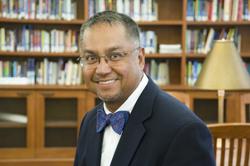Filed Under > Convocation
Giving Care Where It's Needed
Whether in addressing the U.S. nursing shortage or poverty in his native Philippines, Medel Paguirigan focuses on helping vulnerable populations
In the Philippines, a country so poor that the typical family of four gets by on about $4 a day, a kidney donor can receive as much as $2,000. Small wonder, then, that in Manila, the capital city, there is an area called “One-Kidney Island,” where thousands of people have donated a kidney for monetary gain – or that nationwide organ sales to foreign buyers remain brisk despite a 2008 law banning that practice.
Medel Paguirigan, who is receiving his doctorate in education degree in TC’s Executive Nursing Program, made that sad trade the focus of his doctoral dissertation, titled “Sacrificing Something Important: The Lived Experience of Compensated Kidney Donors in the Philippines.”
“My interest is in the vulnerable and marginalized population,” says Paguirigan, who grew up in Manila and is now a clinical instructor at the NYU College of Nursing. “These donors are exploited because of their poverty experience. I was also born poor, so I could identify with them.”
To conduct his research, Paguirigan (pronounced Pa-guh-REE-gun), went to One-Kidney Island, where a friend, Joseph Laban, who had made a documentary on the same subject, connected him with some donors. Paguirigan interviewed 13 of them after their surgeries, asking why they chose to donate and how they felt about selling something as intensely personal as a kidney.
Most expressed mixed feelings about what they had done. They needed and appreciated the monetary compensation and felt good about contributing to the recipient’s health and wellbeing and that of their own families. However, some were still living in poverty, either because they had been cheated by unscrupulous brokers or because all the money had gone to pay creditors. In addition, donors reported receiving poor or inadequate post-operative care, and many were worried about their own health and whether they would be able to work again.
Paguirigan, 49, was part of a wave of Filipino nurses who came to the United States in the 1980s to address a serious nursing shortage. He joined the NYU faculty in 2006 and in 2008 came to TC. He was the only student of the 13 in his cohort to complete his coursework and dissertation in three years, while also teaching full-time at NYU.
As Paguirigan explains, the anticipated U.S. shortfall of 1 million nurses predicted by the year 2020 – at a time when the nation’s aging population will require increased medical care – is likely to have an exponential impact, because today’s lack of qualified faculty prevents schools from training tomorrow’s nurses.
“We’ve already had to turn away tens of thousands of potential nursing school applicants in the U.S. because we don’t have the faculty to teach them,” he says.
Hence Paguirigan’s own plans to continue teaching and training new nurses. “I want to give back to my community,” he said. Right now, his community is New York. Some day, it may again be Manila.
Published Wednesday, May. 18, 2011
